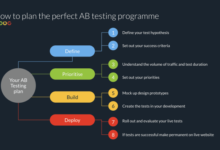
Creating interactive content for better engagement takes center stage, drawing readers into a world of knowledge and creativity. This topic explores the significance of interactive content and how it can enhance audience engagement in various industries.
Overview of Interactive Content
Interactive content refers to digital material that requires active engagement from the audience, allowing them to participate in the experience rather than passively consume it. This type of content encourages users to interact, provide input, make choices, and engage with the material in a meaningful way.
The importance of interactive content for better engagement lies in its ability to captivate and retain the audience’s attention. By involving users in the content experience, interactive materials create a more immersive and memorable interaction, leading to increased engagement, brand awareness, and conversion rates.
Examples of Successful Interactive Content
- In the fashion industry, brands like Burberry have used interactive content such as virtual try-on tools to allow customers to visualize how clothing items would look on them before making a purchase.
- In the education sector, platforms like Kahoot! engage students through interactive quizzes and games, making learning more enjoyable and effective.
- In the travel industry, websites like Airbnb utilize interactive maps and filters to help users explore and select accommodations based on their preferences and needs.
- In the marketing realm, interactive infographics, quizzes, and calculators are commonly used to engage audiences, gather data, and drive lead generation.
Types of Interactive Content: Creating Interactive Content For Better Engagement
Interactive content comes in various forms, each offering unique benefits and limitations. Understanding the different types is crucial in choosing the right one for a specific audience.
Quizzes
Quizzes are a popular form of interactive content that engages users by testing their knowledge on a particular topic. They are effective in driving audience engagement and providing valuable insights into user preferences. However, quizzes may require more time and effort to create compared to other types of interactive content.
Polls
Polls are a great way to gather feedback from your audience on specific questions or topics. They are easy to create and can provide real-time data on user opinions. Polls are effective in increasing user engagement and fostering a sense of community. However, they may not offer in-depth insights into user preferences.
Calculators
Calculators allow users to input data and receive customized results based on predefined algorithms. They are highly interactive and can provide valuable information to users. Calculators are beneficial for websites in industries such as finance, health, or fitness. However, they may require technical expertise to develop and maintain.
Interactive Infographics
Interactive infographics combine visual elements with interactive features such as animations or clickable elements. They are visually appealing and help in simplifying complex information for the audience. Interactive infographics are effective in conveying data-driven stories and engaging users. However, they may require more time and resources to create compared to static infographics.
Augmented Reality (AR) Experiences
AR experiences merge digital content with the real world through a smartphone or tablet camera. They provide an immersive and interactive experience for users, creating a unique engagement opportunity. AR experiences are innovative and can help in showcasing products or services in a creative way. However, they may require specialized technical skills and resources to develop.
Designing Interactive Content

Creating visually appealing interactive content is crucial for capturing the audience’s attention and keeping them engaged. Here are some tips for designing visually appealing interactive content:
Tip 1: Use Eye-catching Graphics and Animations
Utilize high-quality images, illustrations, and animations to make your interactive content visually appealing. Visual elements can help convey information more effectively and enhance the overall user experience.
Tip 2: Maintain Consistent Branding
Ensure that your interactive content aligns with your brand’s visual identity. Use consistent colors, fonts, and design elements to create a cohesive and professional look that resonates with your audience.
Tip 3: Keep It Simple and Intuitive
Design your interactive content in a way that is easy to navigate and understand. Avoid cluttered layouts and complicated navigation menus. Keep the user interface intuitive and user-friendly for a seamless experience.
Tip 4: Optimize for Mobile Devices
With the increasing use of mobile devices, it’s essential to optimize your interactive content for different screen sizes. Make sure that your design is responsive and works well on smartphones and tablets.
Best Practices for User-Friendly Interactive Design, Creating interactive content for better engagement
When designing interactive content, consider the following best practices for creating a user-friendly experience:
- Provide clear instructions and guidance on how to interact with the content.
- Include feedback mechanisms to let users know their actions are being registered.
- Ensure that interactive elements are easy to click or tap on touchscreen devices.
- Test your interactive content with real users to identify any usability issues and make improvements.
Incorporating Multimedia Elements for Enhanced Engagement
To enhance engagement with your interactive content, consider incorporating multimedia elements such as videos, audio clips, and interactive animations. These elements can help make your content more dynamic and captivating for your audience.
Implementing Interactive Content Strategies

Implementing interactive content into a marketing strategy can significantly enhance engagement and drive better results. Here are the detailed steps for integrating interactive content into a marketing strategy:
Step 1: Define Your Goals
- Identify the specific objectives you want to achieve with interactive content, whether it’s increasing brand awareness, generating leads, or improving customer engagement.
- Set measurable goals that can help you track the effectiveness of your interactive content strategy.
Step 2: Know Your Audience
- Understand your target audience’s preferences, interests, and behaviors to create interactive content that resonates with them.
- Segment your audience based on demographics, psychographics, and past interactions to deliver personalized interactive experiences.
Step 3: Choose the Right Interactive Content Format
- Explore different types of interactive content such as quizzes, polls, calculators, interactive infographics, and interactive videos to find the best fit for your goals and audience.
- Consider the level of engagement each format offers and select the one that aligns with your marketing objectives.
Step 4: Create Compelling and Relevant Content
- Develop interactive content that is informative, entertaining, and relevant to your target audience’s needs and interests.
- Focus on providing value and solving problems through your interactive content to build trust and credibility with your audience.
Measuring the Effectiveness of Interactive Content
To measure the effectiveness of your interactive content strategy, track key performance indicators (KPIs) such as engagement rate, click-through rate, conversion rate, time spent on interactive content, and lead generation. Use analytics tools to monitor and analyze the performance of your interactive content and make data-driven decisions to optimize your strategy.
Examples of Successful Companies Using Interactive Content
- BuzzFeed’s interactive quizzes have been a hit with audiences, driving high engagement and social sharing.
- Trello’s interactive tutorial boards help users learn how to use their project management tool effectively, increasing user adoption and retention.
- Nike’s interactive shoe customization tool allows customers to design their own sneakers, creating a personalized shopping experience that boosts sales and brand loyalty.
Tools and Platforms for Creating Interactive Content

When it comes to creating interactive content, there are several tools and platforms available to help you engage your audience in a more meaningful way. These tools offer various features and capabilities to make your content more interactive and engaging. Choosing the right tool for your project is essential to ensure that you achieve your desired outcomes effectively.
Popular Tools and Platforms for Developing Interactive Content
- 1. Adobe Animate: Adobe Animate is a powerful tool for creating interactive animations and multimedia content. It offers a wide range of features such as timeline-based editing, interactive components, and export options for web and mobile platforms.
- 2. Canva: Canva is a user-friendly design tool that allows you to create interactive graphics, presentations, and social media posts. It offers a variety of templates, fonts, and graphics to enhance your interactive content.
- 3. Ceros: Ceros is a platform specifically designed for creating interactive content experiences. It offers drag-and-drop functionality, animation tools, and analytics to track user engagement.
- 4. Playbuzz: Playbuzz is a content creation platform that enables you to create interactive quizzes, polls, and storytelling experiences. It provides templates and customization options to tailor your interactive content to your audience.
Comparison of Features of Different Tools for Creating Interactive Content
- Adobe Animate: Ideal for complex interactive animations, but requires advanced skills.
- Canva: Great for beginners with its easy-to-use interface and pre-designed templates.
- Ceros: Offers sophisticated interactive features and analytics for in-depth user engagement tracking.
- Playbuzz: Focuses on interactive quizzes and storytelling formats for audience interaction.
Guidance on Selecting the Right Tool Based on Project Requirements
When selecting the right tool for creating interactive content, consider the complexity of your project, your team’s skill level, and the desired outcome. If you need advanced animations and interactions, Adobe Animate might be the best choice. For beginners looking for a user-friendly platform, Canva could be a suitable option. Ceros and Playbuzz are ideal for those focusing on interactive experiences and audience engagement tracking. Evaluate your project needs and choose the tool that aligns best with your goals.
Final Summary

In conclusion, the discussion on creating interactive content for better engagement delves into the diverse forms of interactive content, design tips, implementation strategies, and tools available. It emphasizes the crucial role of interactive content in modern marketing and audience interaction.
When it comes to scaling server resources, it is essential to have a clear strategy in place. Understanding the needs of your website or application is crucial in determining the amount of resources required. By following best practices and utilizing tools like cloud computing services, you can efficiently scale your server resources as needed.
For more detailed information on how to scale server resources, you can refer to this informative article: How to scale server resources.
Content marketing can be a powerful tool for businesses, even on a budget. By focusing on creating high-quality, engaging content and leveraging social media platforms, you can reach a wider audience without breaking the bank. Implementing strategies such as repurposing content, collaborating with influencers, and utilizing email marketing can help maximize your efforts.
To learn more about effective strategies for content marketing on a budget, check out this insightful article: Strategies for content marketing on a budget.
Ensuring the security of server data is paramount in today’s digital landscape. Implementing robust security measures such as encryption, access control, and regular data backups can help protect sensitive information from cyber threats. It is also important to stay updated on the latest security trends and technologies to mitigate potential risks.
For comprehensive guidelines on how to secure server data effectively, you can refer to this valuable resource: How to secure server data.









